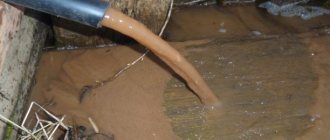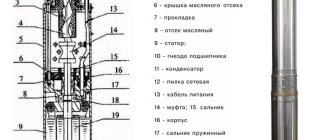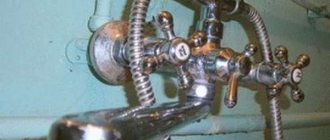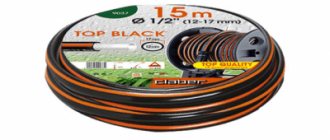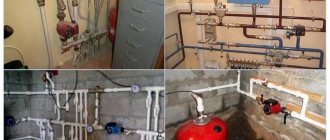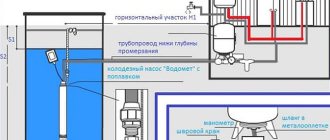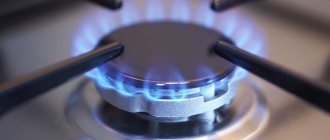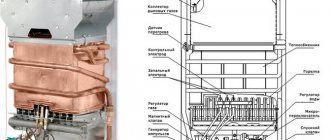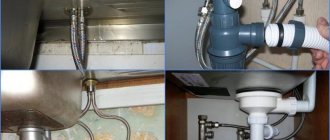Water is the basis of life, this is a well-known truth, and in a country house you cannot do without water at all. But before installing a water supply system, it will be necessary to carry out some preparatory work. First, you must decide on the water supply method, since the entire work plan will depend on this. So, let's take a closer look at the possible options for water supply at home, as well as the technology for organizing this process.
- 2 Sources of water supply for the home
- 3 Which source to choose
- 4 Diagram of the water supply system in the house
- 5 Stages of creating a water supply system
- 6 Organization of water supply from a well
- 7 Organization of water supply from a well
- 8 Water supply for a country house (video)
If the pump sucks air from the well. Why is there air in the water from the well and what to do
Residents of private houses, dachas, and country houses often have an urgent need to install a pump structure for pumping water from a well or borehole.
For some, this is the only way to have water in the room. Therefore, when, one fine day, the pump stops humming, it is urgently necessary to understand the origin of the breakdown. If the pumping station stops pumping water, it is urgent to find the cause of the breakdown
Often the stumbling block is the air that gets into the pump along with the liquid. Everything can be prevented, you just need to initially find out what elements the pump structure is assembled from.
Key components of the pumping unit
There are many types of stations, but the basic components are common to all.
- Self-priming pump. Operating principle: the pump independently draws liquid from the recess using a tube, one end of which is located in the well, the other is connected to the equipment. The pump is located a short distance from the water container. The depth of the tube is also adjustable.
- All units are equipped with a hydraulic accumulator. Using the energy of compressed gas or a spring, the vessel transmits liquid under pressure into the hydraulic system. It accumulates hydraulic fluid and releases it at the right time, thereby avoiding water surges in the system. It is metal on the outside, there is a rubber membrane inside, a gas cavity filled with nitrogen is placed above it, and a hydraulic cavity is located below it. Water is filled until the pressure in both cavities is equal.
- Electrical engine. It is connected to the pump via a coupling, and to the relay via an electrical circuit. Due to the fact that the pump does not turn on for short liquid intakes, the motor does not wear out.
- Air release pipe.
- Collector element.
- Pressure gauge. It allows you to monitor your blood pressure levels.
- Relay. By changing the pressure, by opening/closing contacts, it supports the independent operation of the equipment.
The main purpose of pumping stations is to maintain continuous pressure in the water supply structure
In order for all components to function like a clock, it is important to correctly select the required volume of the accumulator and control the connection between the regulator and the pump itself.
Operating procedure of the unit
When turned on, the electric motor comes into play first, it starts the pump, and it pumps the gradually flowing liquid into the hydraulic accumulator. When the battery is full to capacity, excess pressure will be created and the pump will turn off. When you turn off the faucet in the house, the pressure decreases and the pump starts working again.
A battery is placed in the house, connected to the water supply. The pipes fill with water when the pump starts working. When the pressure in the station reaches the required peak, the pump turns off.
The pumping unit will solve the problem of supplying water to houses, bathhouses, summer kitchens, outbuildings and other premises on your site. Having familiarized yourself with the details of the station’s operation, it is necessary to study the possible causes of device failure and ways to eliminate them.
The most common breakdowns encountered
In the process of using any equipment, there comes a time when it either wears out or breaks.
So in the second case, it would be important for the owner to understand the causes of the damage. Here is a short list of reasons that interfere with the operation of the pumping station:
- no electricity - trivial, but also not impossible, since the operation of the unit directly depends on the electric current;
- the pipeline is not filled with liquid;
- pump malfunction;
- the hydraulic accumulator is broken;
- automation is damaged;
- cracks in the body.
The pump turns, but does not pump water
What to do when the station does not pump water? A frequent cause of breakdown is the lack of liquid in the pipes or in the pump itself. It happens that the unit is functioning, but does not pump water. Then you should check the tightness of the entire water supply system to see if there are any places where the pipes are poorly connected.
Check that the pump is not empty. The check valve is not working properly. The bandwidth must be one-way. This is one of the most important parts of the station, since, after turning off the pump, it prevents water from flowing back into the well.
Diagram of a pumping station valve that can become clogged with debris
It happens that the valve is clogged and does not physically close; debris, salts, and grains of sand can get into it.
Accordingly, the liquid does not reach the pump. Let's solve the problem.
Before spinning up the unit, we recommend checking the electrical voltage. It happens that it is below normal, and the pump is simply unable to turn on. Etc
Current requirements
The quality of drinking water is regulated by SanPiN 2.1.4.1074-01. The main requirement of sanitary standards is that water should not pose a danger in epidemiological and radiation terms. It should be harmless in chemical composition and have pleasant organoleptic characteristics. The quality of the water environment must comply with hygienic standards before being supplied to distributors and at water distribution points in the water supply network.
With regard to technical standards for aquifer pipelines, SNiPs and TKP impose the following requirements:
- supplying specified volumes of liquid to water consumption points under the required pressure;
- high level of reliability and uninterrupted water supply;
- accessibility of utilities for water consumers;
- cost-effectiveness of water supply systems projects, involving a minimum of costs for arrangement and operation.
Fulfillment of the requirements is achieved by competent selection of the configuration of the water supply system and pipe material, as well as the correct determination of the technological and economic characteristics of all parts of the pipeline.
Reasons for the appearance of air in a water well
If the pressure has become too low, there is air in the system.
As a rule, households who use small volumes of water from a source or when using pumping equipment seasonally face the problem of air getting into the water. The causes of this phenomenon may be the following problems in the system:
The air suction at the water suction point has failed. The problem will not be solved until the pipeline is completely replaced with all the necessary parts. It’s easy to make sure that it’s working properly – just pump the water in the pipeline, for example, in the bathroom. Breakdown of the pumping equipment itself due to irregular or poor quality maintenance. Air bubbles are formed as a result of a weak gland seal. The solution to the problem is to disassemble the working unit of the station and fix the damage. Insufficient filling level of the well during large pumping. Drilling a new well, purchasing a less powerful pump, reducing the volume of water used can solve the problem
However, when drilling a new well, it is important not to reach the same aquifer, where the likelihood of airing the system again is very high.
Stages of creating a water supply system
The main points when creating a water supply system in the house are the following:
- water supply system is selected
- Select a location to create the source.
- A well or well is created
- A water supply system is created using a caisson, pump or plastic water storage tank.
- Direction of water supply to the house.
- The supply of water to the battery or storage tank is organized
To organize a water supply system for your home, you will need the following:
- ready source;
- pump or station;
- external water supply ;
- hydropneumatic tank;
- pumping station for the 2nd lift, if necessary;
- cleaning filters;
- auto protection and electrical system;
- internal system for supplying a house, which consists of a pipeline, as well as connecting parts, valves, water taps, valves, mixers, etc.
Cavitation and its elimination
As practice shows, cavitation is the most common problem faced by owners of household plots with an autonomous water supply system.
The cause of cavitation is incorrectly selected pumping equipment. Water devices are selected taking into account the diameter of the well. For sizes less than 100 mm, plunger or circular models are suitable, 100 mm and more - submersible.
Cavitation is a violation of the density of the water column, in other words, the filling of the pipeline with air bubbles. Formed in areas with reduced pressure at a critical level. The phenomenon is accompanied by the formation of voids in the pipeline, bubble formations formed as a result of the interaction of gases and vapors released by well water.
It is not always possible to determine the faulty area yourself, since special equipment is required. It is also worth adding that this area may be unstable. If measures are not taken, the consequences will hit the pocket hard - dynamic effects on flow and vibration will lead to breakdown of pumping equipment.
To reduce the likelihood of a problem developing, you need to choose the right water pumps, taking into account the volumes of water consumed and the technical characteristics of the well.
To get rid of such an unpleasant phenomenon as the appearance of air in water, you need to consider the main ways to solve the problem:
Replace the small diameter pipe with a larger diameter pipe. Install pumping equipment closer to the storage tank
When transporting the pump, it is important to take into account the established standards: the interval between the container and the pump must be no less than 5 diameters of the suction pipe. Replace the valve with a gate type and remove the check valve. To reduce the pressure in the pipeline, the pipe is replaced with a smooth one. There should not be many turns in the suction pipe
To solve the problem, you need to replace small radius bends with large ones or simply reduce them. At the design stage of an autonomous water supply system, it is recommended to place all outlets in the same plane and use flexible pipes rather than rigid ones.
Application area
Water supply is the collection, preparation and transportation of water to consumers.
Water is used for various needs, which come down to three parameters:
- for household and drinking consumption;
- for the activities of industrial facilities;
- for extinguishing fires.
This classification by purpose applies to all water supply systems. The fire-fighting network will be additionally equipped with special equipment and hydrants. Usually it is made a dead-end, so that the highway can be combined with household and industrial supplies.
Drinking water supply is not combined with facilities that transport water for technical purposes.
According to the renewability of sources, water supply networks are divided into circulating and single-use. The classification of water supply also involves division into cold water supply systems and hot water supply.
Why does a well pump pump water with air?
Increasingly, wells are used instead of wells in rural areas and private houses in holiday villages. Water is pumped from a well with a pump. The design of the pump also depends on the diameter of the well. For a 100 mm well, a submersible pump is suitable; for a well of smaller diameter, circular or plunger pumps will be used
Over time, during operation, you may notice that the pump began to pump water with air bubbles. There may be several reasons and all of them require careful inspection and replacement of worn elements
To identify the causes, you should carefully consider the essence of the problem.
- The simplest option is air leakage in the suction pipeline, and the column of water in the pipe can remain for a long time. It is treated by replacing the pipeline and replacing related elements, so as not to change them later.
- The second option is insufficient flow of the well, when, with a high water flow, the well does not have time to fill and the pump sucks in air.
- The third option is a malfunction of the pump itself, when air enters the discharge chamber through a faulty gland seal. To replace the seals, it is necessary to disassemble the pump unit, ideally take it to a repair shop.
- The fourth option is when the pressure chamber of the pump creates conditions for cavitation to occur (this is when a liquid substance at high pressure turns into a vapor state. It appears when the suction level drops below 8 meters.
The same laws apply in hydraulic systems as in electrical circuits. To specifically determine a breakdown, it is necessary to carry out a number of technical measures, which an ordinary person is unlikely to do on their own. Most owners of borehole pumping systems turn to pump service specialists.
Water distribution schemes
Plumbing wiring according to the method of execution can be:
- sequential or tee;
- fan or collector;
- mixed - when combining the first two types in one room.
Each plumbing scheme has advantages and disadvantages. In the first case, the advantage is ease of installation and cost-effectiveness, and the disadvantage is the dependence on water pressure when distributing it to consumers. The second type ensures uniform pressure in all outlet pipes. Each pin can be independently overlapped without disrupting other consumers. The downside is the expense of construction materials and time spent on installation. The best option is the third type of distribution of main branches.
When organizing a water supply system, compliance with GOST of all building materials, especially pipe sections and fittings, must be taken into account. Particular attention is paid to shut-off valves. It is placed on connections to faucets, toilets, flush cisterns and washbasins. For proper functioning of the network, you should also install a plunger - a device for releasing air bubbles. It is recommended to retrofit the network with a bypass - a spare pipeline for emergencies.
Water supply is a complex multifunctional process. In order for all systems and devices to operate smoothly, you need to take a responsible approach to design work, select high-quality building materials and strictly follow the technology for installing highways.
Causes of air locks in pipes
This by-product contains approximately 32% oxygen, that is, there is a third more oxidizing substance here than in the atmosphere. The freely expressed form of these clusters is not the same. Only bubbles up to 1 mm can be considered spherical. A larger number may have an ellipsoidal or mushroom-shaped topology. In vertical sections of water supply risers, air-gas inclusions rise upward or remain suspended. In horizontal pipelines they always “stick” to the walls at the highest point, which can create conditions for active rusting of the pipes
Converting sensible heat into latent heat
For cooling, the heat pump can be used directly and cooled by underfloor heating. The advantage of this action is that we preheat the earth's heat exchanger during the winter season. The conversion of sensible heat into latent heat is based on what is called adiabatic cooling. We use the fact that evaporation is cooled or energy, expressed as air temperature, is consumed by the process in which water changes from a liquid to a gaseous state.
When the water speed begins to exceed ½ m/s, air accumulations begin to move along with it. If the liquid flows in the circuit faster than 1 m/s, then the air in the water supply system breaks into tiny capsules and a kind of emulsion of gas and liquid is created. Practical observations have revealed that the minimum rate of destruction of such accumulations in a water supply system is about ¼ m/s. With a lower flow rate, air pockets can remain in the same areas for a long time, which is undesirable.
Therefore, heat is not consumed to increase the temperature of the water, but to make structural changes in the substance. We call the stored energy latent heat. Direct adiabatic cooling is achieved by spraying water into the air supplied inside. This type of cooling can be used in hot and dry climates or in special operations where we need high air humidity. This is an air conditioner called an air puck.
The advantage of direct adiabatic cooling is that it does not represent an investment that already has mechanical air conditioning installed, since air humidification is usually part of it. The disadvantage is higher maintenance requirements. The shower stall needs to be cleaned regularly to avoid dangerous bacteria.
To get rid of air accumulations, various bleed/bleed devices are used. These include automatic air vents, mechanical valves (for example, the “Mayevsky valve”), and conventional shut-off valves (valves, ball valves). A standard regulator of this kind is made in the form of a cylindrical shell with a flat cover. In the center of the latter there is a threaded plug with a hole of 3-5 mm. A float ball made of polymer or cork is placed inside the body. When there is no air in the pipes, this element tightly closes the hole in the lid under the influence of network pressure. If an air accumulation appears in the device, the ball falls for a moment and allows this mixture to escape through the hole in the lid.
Air vents are also able to perform the opposite effect - to introduce a certain amount of oxygen into the pressure network. This happens accidentally or is necessary when quickly draining the resource before inspecting and repairing the water supply.
In order for the air in the water supply system to be removed in a timely manner, it is necessary to correctly install its release mechanisms at the required points. They are mounted at the top points of pipelines, at kinks or bends, since this is where the air-gas mixture accumulates.
Some types of repair work
Some steps to repair a pumping station with your own hands are intuitive. For example, cleaning a check valve or filter is not difficult, but replacing a membrane or bulb in a hydraulic accumulator can be difficult without preparation.
Replacing the “pear” of the hydraulic accumulator
The first sign that the membrane is damaged is frequent and short-term switching on of the pumping station, and the water is supplied in jerks: sometimes strong pressure, sometimes weak. To make sure that the problem is in the membrane, remove the plug on the nipple. If it is not air but water that comes out of it, then the membrane is torn.
The membrane tank device is useful when replacing the pear
To begin repairing the hydraulic accumulator, disconnect the system from the power supply, relieve the pressure - open the taps and wait until the water drains. After this you can turn it off.
The following is the procedure:
- Loosen the flange at the bottom of the tank. We wait until the water drains.
- Unscrew all the bolts and remove the flange.
- If the tank is 100 liters or more, unscrew the membrane holder nut at the top of the tank.
- We remove the membrane through the hole in the bottom of the container.
- We rinse the tank - there is usually a lot of rust-colored sediment in it.
- The new membrane must be exactly the same as the damaged one. We insert the fitting into it, which secures the upper part to the body (tighten it).
- We install the membrane in the accumulator tank.
- If there is one, install the membrane holder nut in the upper part. If the tank is large, you won't be able to reach it with your hand. You can tie the holder to a rope and install the part in place by screwing on the nut.
- We tighten the neck and press it with a flange, install the bolts, sequentially tightening them several turns.
- We connect to the system and check the operation.
Replacement of the pump station membrane is completed. The matter is not complicated, but you need to know the nuances.
Why does air appear in the water supply?
In our work, we focused on electric compression heat pumps because they are currently more competitive than gas absorbers, although the latter reduces their costs significantly. The car still heats up, but it consumes more. We're talking about costs: how much does it cost depending on the technology you choose?
Since air is the cheapest and easiest to install; air-to-water and water-to-water are more expensive because you need to add the costs of integration with the heating system, boiler and secondly, the well. Then a 10 kW heat pump for water, the size of which is suitable for a cottage, can cost about 5-6 thousand euros.
There are two reasons for the appearance of air in the water supply system of a home:
- Outside
. Air enters the pipes through leaky connections; - From the inside
. Approximately 30 grams of air per 1 ton of water is dissolved in the water flow passing through the pipes. Gradually the air is released. The slower the water flows and the hotter it is, the faster the process goes. That is, in hot water supply systems the likelihood of air locks occurring is higher.
Air appears in the water supply systems of private houses for the following reasons:
In your work you have made various economic models. In what areas have you found that heat pumps provide the greatest savings? Highest level of convenience in commercial scrappers: in general, the payback period for these users is 2-3 years, shorter than domestic ones. This mainly depends on two factors. Firstly, there is usually no need to heat hot water in a business, so the cost of fitting a boiler or integrating a heat pump into the installation is lower. Secondly, commercial environments use heat pumps much more for summer air conditioning since these environments, unlike residential ones, have a lot of daytime activity.
- when the water level drops, air can be sucked in through the check valve;
- fittings with rubber seals are not tightened well;
- in hot water supply systems, a process of cavitation is observed: steam is formed, air bubbles collect in the water, forming voids or cavities;
- air in the water supply pipes remained from the first start-up of the equipment.
Air bubbles contain 30% more oxygen than atmospheric air. This explains the high oxidizing capacity of air in hot water supply systems. Air bubbles can be of various shapes: spherical - small, no more than 1 millimeter in diameter, mushroom-shaped, oval.
Can we give some rough estimate of the savings a heat pump can provide and how long it takes to see a return on the investment? In the simulation we made for the business sector, investments are repayable in 3-6 years without incentives, in 2, 4, 5 years with deductions and under 5 taking into account heat.
According to wells, many people who drift toward their own water supply often ignore water amenities. They will call when they run out of withers or even clean water. Each spike well introduces even minor illnesses into the trench, which then calm down. It depends on the composition of the soil in which it is kicked. Wells in hard rock of this mining hazard that are good in murky mud should have been observed more.
When the water speed in the pipes is more than 0.5 meters per second, the bubbles move without stopping. When the speed exceeds 1 meter per second, the bubbles break into very small bubbles. It turns out like an emulsion of water and air. Air bubbles in the water supply system of a private house begin to collapse at a fluid speed of 0.25 meters per second. If it is lower, traffic jams may stagnate in some places for quite a long time.
The big danger of large layers of sediment at the bottom is the likelihood of infection by bacteria, which can enter the well not only with water, but also with weak clogging of the well. Sludge is good for them, anyone who wants to use water for drinking should keep this in mind.
Fountains are often faced with the fact that there is a water supply in a seemingly “dead” well that the owner has not known for a long time. It is impossible to say in general in what period of time it is found out, it usually passes once every two to three years, it may still remain on the well in a stone bed, but the condition of the well is checked twice a year. and there’s no need to address moss on the walls,” Elfer explains.
Problems and malfunctions of pumping stations and their correction
All pumping stations consist of the same parts and their breakdowns are mostly typical. It makes no difference whether the equipment is Grundfos, Jumbo, Alco or any other company. The diseases and their treatment are the same. The difference is how often these malfunctions occur, but their list and causes are usually identical.
Pumping station installation options
The pumping station does not turn off (does not gain pressure)
Sometimes you notice that the pump has been running for a long time and will not turn off. If you look at the pressure gauge, you can see that the pumping station is not gaining pressure. In this case, repairing the pumping station is a long process - you will have to go through a large number of reasons:
Do-it-yourself pump station repair will help you save money
How to get rid of air in pipes
If there is already air in the water supply system of a private house, but it is not equipped with bleeders, you must:
- Turn off the pumping station.
- Open all drain taps and release water and air from the water supply system. After which the pipes are filled again.
You can remove air from the water supply system once and for all using bleed or drain devices:
- mechanical valves such as the Mayevsky valve;
- automatic air vents;
- ball valves;
- valves
Mechanical air release valve device
from the water supply system is as follows: a cylindrical box, closed with a lid at the top, and a thread at the bottom for connecting to the water supply. There is a threaded plug in the middle of the lid. A plastic float in the shape of a ball is suspended inside the cylinder. If there is no air in the hot water supply system, the ball rises to the hole in the plug and closes it tightly under network pressure. As soon as air enters the device, the ball moves away and the air is released. Air can enter the system through the bleeders, which is useful when repairing or inspecting networks and speeds up the drainage of water.
But once a person invests in a hostage, it might not be a bad idea to get one test done early and one before the hospital. This allows you to compare the difference between water quality and spring quality. Whoever polluted the water before and after it has a certain guarantee that the spring provides drinking water. And to conclude that he only neglected regular maintenance.
If contamination occurs within the next three days, it is worse. Obviously, water is obvious, and if it is to be used for drinking, it is necessary to find a water filtration specialist and prepare for a multi-level edition. Patience is not difficult for those who are afraid of hard and dirty work. However, he must adhere to several key principles.
Homemade air accumulator
In rural water pipes, air often flows mixed with water. Using such a water supply is difficult and inconvenient, and the automation does not always cope: if there is a lot of air, the water overflows like a fountain directly from the valve. Therefore, instead of an automatic air bleeder, an air accumulator
. You can make it yourself; it is a tank with an outlet pipe and a tap. The diameter of the storage tank must be 5 times larger than the diameter of the water pipe, then it can work effectively.
Especially in deep fountains there is a layer of poisonous gas. Therefore, it is necessary for the unfortunate person to come into the depths to secure the rope. In case of danger, his colleague can come out. After the shots you don't fall into a deep well, you need to get a stick with a rope. Don't even think about using a small mud pump from the hobby market for a thousand crowns. Often the spring is so fertile that even professional pumps do not place the “dry” well. And these are tools costing up to 40 thousand CZK with a three-phase electric motor.
Then it is not enough to use a rental company, prices range from 250 to 500 CZK per day, but you need to pay a deposit of about 10,000. With the wells we went to the hospital that the owners had neglected for 15 years. An old well in a 200-year-old building. Although the original hole was equipped with springs, no one thought about the wellbore around the cain. The old vaults and blocks have already begun to collapse, the remains of the gardens fall directly into the well. Now is the time to start with reconstruction.
Installation features
Installation of the water supply can be carried out from the consumer to the collector or vice versa. But let's consider a situation in which the installation is performed from the consumer down. Let's take a two-story cottage as an example:
- A pipe is installed on the second floor (it will be a riser), and a 900C outlet is attached to its upper part. This section of the pipe is attached to the ventilation shaft using special clips.
- A small section of the pipeline is connected to the outlet, to which a ball valve and, if necessary, a water meter will be attached.
- After the water meter, it is necessary to leave a threaded connection. The hoses from your mixer will then be connected to it.
- A pipe of a size sufficient to connect to the future water collection point on the ground floor is installed at the bottom of the riser. Then a tee is attached to it, from which a section of the pipeline will go to the mixer.
- A section of pipe is connected to the tee to connect the riser to the manifold. In the future, it will be connected to the central water supply entrance in a private house.
Note! There must be sufficient distance between the cold and hot water risers for their maintenance. Sleeves should be used to pass through floors and walls. Fastening with clips should be done every 1-2 meters. In order to be able to perform quality maintenance in the future, it is recommended to install shut-off valves before connecting the riser to the collector. In this case, during repairs, it will be possible to turn off only the necessary riser, and not the entire house.
As for the diameters of pipelines for the water supply of a private house, it should be noted that their parameters depend on the number of water points. If you are using a collector circuit, and the height of the house is no more than 5 floors, then a cross-section of 100 mm will be sufficient for the collector, and 32 mm for the risers. For room-to-room wiring, the optimal diameter is considered to be 20mm.
Note! After completing the construction of intra-house water supply networks, it is necessary to conduct a test run. During this process, the installers (or you directly, if you installed the water supply yourself) with a flashlight must go around all the connections and visually check them for leaks. If no drips have formed within 20-30 minutes, then the work has been done efficiently.
Water from a well comes with air. Why is water supplied with air?
The popular idea is that artesian water is something like gold and is pure, like the soul of a baby. But in reality it is just a well drilled into a confined aquifer. This means that having drilled down to the aquiferous limestones, the water level will rise higher than it was. That's all, such waters are called artesian, which makes the quality of artesian water no better or worse than in ordinary free-flow limestone wells. Artesian is just a term, but today they have begun to designate all wells on limestone. Sometimes the water level rises so high that it begins to flow out of the well itself. We wrote about self-outpouring.
The most important thing in artesian wells is not the purity of the water, the main thing is the flow rate. It is enough to supply water to any private home, industry or even a village. This is why drilling artesian wells for water has become so popular today.
Now we will tell you the whole truth about artesian wells and what is important to know about them.
At what depth is artesian water
No one can definitively answer at what depth to drill an artesian well, including magical dowsers. There is only one reason for this: geology. Artesian water lies in limestone (which is why it is sometimes called a limestone well) and these aquiferous limestones can be located at any depth, sometimes 50 meters, and sometimes 150 meters. To find out at what depth artesian water lies, you need to look at a map of the depths of wells in the Moscow region (or your region), or even better, interview neighbors who have already drilled a well. It is very likely that you will have something similar. In your region, artesian waters may lie in other rocks, but this does not change the essence of the matter.
Artesian well pros and cons
It is important for you, as the owner of a house, to have a sufficient amount of water, which means there are no alternatives and you need to drill for limestone. This is the first and most basic advantage of an artesian well - high flow rate. No sand wells can compare with it in this component
The second plus and second advantage of an artesian well: there is always water. Regardless of the season, be it summer or winter, rain or drought, the water level in the well is stable and the pressure is also stable.
Maintenance of a proper artesian well is never required at all, this is another plus. A competently (!) made structure will last its entire service life and you do not need to worry about it. Typically, the service life of an artesian well is more than 50 years. This is possible with proper arrangement, provided that high-quality pipes, materials and quality work are used. Unfortunately, today no one does this; today everyone is trying to give the lowest price. Only water-lifting equipment requires maintenance, but that’s a completely different story.
- Debit.
- There is always water.
- Does not require maintenance.
- Water quality.
Water supply for apartments
To understand how the water supply to apartments occurs, you should consider the most popular connection schemes.
- Consistent water supply. With this connection, hot and cold water pipelines run in parallel, so tees are used to connect various equipment. Consistent water supply does not require high costs, and water is supplied to users from a common main.
- Collector water supply. This connection scheme ensures constant pressure in the system, without drops and shutdowns. High pressure allows you to turn on plumbing fixtures simultaneously, since separate pipes go to consumers. The collector circuit is considered quite expensive, and its installation requires knowledge as well as specialized tools.
What to do?
Most likely, the troublesome option with independent assembly and disassembly, draining and filling and checking all elements of the system will not suit you. If this is the case, we see two possible solutions:
- Contact specialists. If your spouse is not good at pumping and hydraulics, this may be the best solution. Spend money, but save time and nerves.
- Try to squeeze the air out of the system. Let’s make a reservation right away: the method can be effective only for the above-described cause of airing No. 3; in case 1 or 2 it is useless. The plan is this: most likely, the pumping unit contains a gas-air mixture with a large number of small bubbles, which prevent the creation of pressure sufficient for normal operation of the system. This “oxygen cocktail” needs to be forced out of the system. How to de-ventilate a pumping station? This can be done by increasing the pressure in the supply line. To do this, in front of the station, cut into the supply a tee with an additional pipeline, into which water is supplied under pressure parallel to the main intake. If possible, temporarily connect from a neighbor's water supply. It doesn’t work - place an open tank with a filler neck as high as possible. The tank capacity must be large enough: there must be enough water to pump the system. If the container is small, you will have to monitor the water level and add it through the funnel.
It is advisable to place the additional capacity higher. A rise of 1 meter gives an increase in pressure of 0.1 bar. Knowing what pressure you have in the system now, you can calculate to what height the tank should be raised
If the station launch using this method is successful, there is no need to disassemble the additional system. It is advisable, at a minimum, to leave a section of pipe from the tee to the shut-off valve. If air bubbles appear in the feed, a significant part of them will fall into this vertical section, which is a kind of air trap. By opening the valve, the accumulated air can be released.
Source of the article: https://grand-haus.ru/strojka-i-remont/nasosnaya-stanciya-podsasyvaet-vozduh.html
Main tasks of the device
To know how to choose a hydraulic accumulator, it is important to clearly understand what tasks it can solve. So, the hydraulic accumulator solves the following series of problems:
- the hydraulic accumulator is designed to maintain a given level of water pressure inside the system;
- the hydraulic accumulator-receiver should reduce the number of pump starts;
- hydraulic accumulators are designed to reduce the likelihood that there will be hydraulic shocks in the system;
- hydraulic accumulators retain a certain supply of water if there is no electricity for some reason.
It is very important that if there are any malfunctions of the hydraulic accumulator, they must be corrected immediately. This will help avoid serious consequences and accidents.
So, if you take a close look at the problems that hydraulic accumulators solve for water supply, you can come to the conclusion that they can extend the life of the pump for a long time. In addition, hydraulic accumulators for water supply are often necessary for backup water replenishment. It is very convenient and practical
It does not matter what kind of horizontal or vertical accumulator you have. Its operation will depend on the setting and application
If we take into account that the hydraulic accumulator (or rather its tank) has a usable volume of around forty percent, then we can find out how much “spare” water we get. The most optimal tank volume that is best to buy is one hundred liters. There is no need to try to buy a large tank if it will not be used at full capacity.
Important! If there are only two people living in the house, then it is enough for them to purchase a 24-liter hydraulic accumulator
The calculation is still simple. It is confirmed by practice. If three people live, you can purchase a 50-liter tank
Well, for four people you need to pay attention to tanks of 80 liters and above. There is probably no need to purchase a large tank for a family of two
This can be more expensive both during purchase and during operation.
Air vent in a water supply system: purposes of application, installation location, alternative solutions
Automatic vent for hot water supply
Today we have to find out why we need to install an air vent in the water supply system. In addition, we will find out in which part of the water supply circuit it can be installed, what kind of air vents can be used there, and how to solve the problem of air in the water supply without an air vent. Let's get started.
